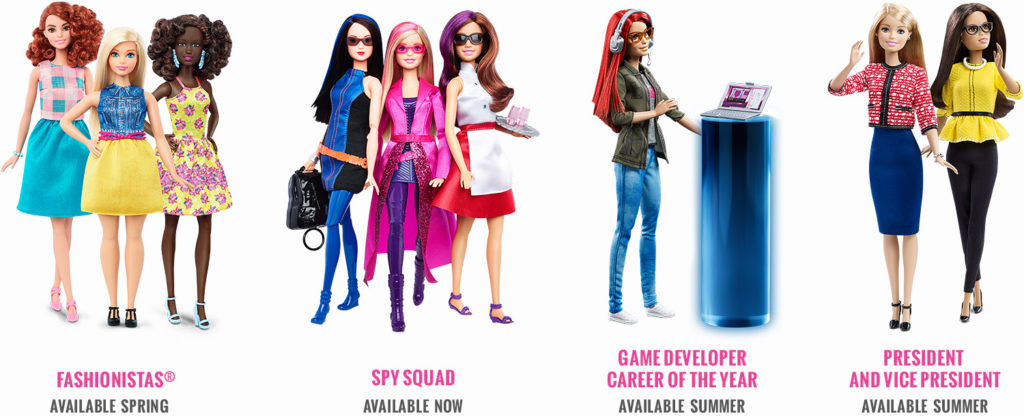Barbie Career of the Year as a Window on Centrist Feminism
 First, I’m excited to announce that you can now pre-order the first segment of the new cast recording audiobook of Terra Ignota that’s being done by Graphic Audio. I’m really excited about this new audio set, which is doing the whole series broken down into volumes so this first release is the first half of book 1. I’ll write about it at greater length soon, but what I love is how the different voices with their different accents make you so much more aware of the global/international nature of the characters and setting, and the amazing director Alejandro Ruiz worked with me on some really exciting experiments with gender and casting, casting a lot of roles against what one might expect, so that the voices and physical descriptions and pronouns are all mismatched, enhancing the way Mycroft’s strange use of gender in the narration disrupts the reader’s perception of character gender, inviting the reader reflect on how perceived gender affects our feelings toward characters. We also got to do some really great representation in the casting, including not only race and nationality, but also a fantastic nonbinary performer doing Sniper and a brilliant trans woman doing Carlyle. I’ll reflect more later on but I’ve stayed up irresponsibly late more than once being unable to stop listening to the audio files, so if you enjoy the books and enjoy audiobooks I think you’ll love them! (Though the best of all possible Terra Ignota experiences definitely also involves listening to the Derek Jacobi audiobook of the Fagles Iliad right before you read book 4…)
First, I’m excited to announce that you can now pre-order the first segment of the new cast recording audiobook of Terra Ignota that’s being done by Graphic Audio. I’m really excited about this new audio set, which is doing the whole series broken down into volumes so this first release is the first half of book 1. I’ll write about it at greater length soon, but what I love is how the different voices with their different accents make you so much more aware of the global/international nature of the characters and setting, and the amazing director Alejandro Ruiz worked with me on some really exciting experiments with gender and casting, casting a lot of roles against what one might expect, so that the voices and physical descriptions and pronouns are all mismatched, enhancing the way Mycroft’s strange use of gender in the narration disrupts the reader’s perception of character gender, inviting the reader reflect on how perceived gender affects our feelings toward characters. We also got to do some really great representation in the casting, including not only race and nationality, but also a fantastic nonbinary performer doing Sniper and a brilliant trans woman doing Carlyle. I’ll reflect more later on but I’ve stayed up irresponsibly late more than once being unable to stop listening to the audio files, so if you enjoy the books and enjoy audiobooks I think you’ll love them! (Though the best of all possible Terra Ignota experiences definitely also involves listening to the Derek Jacobi audiobook of the Fagles Iliad right before you read book 4…)
Meanwhile… Why I Care About Barbie’s Career of the Year:
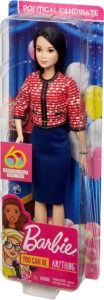
This topic is very far from my usual bailiwick but important in its odd way, expanding on a Twitter thread from 2020. I am not, nor have I never been, a Barbie collector, but I find the Career of the Year series fascinating as a metric of public attitudes toward feminism. In the broad spectrum of feminist discourse, the fringes and harsh or stinging voices are often the loudest (the progressive left & conservative right), making the Mattel Barbie team an informative contrast.
Generally Mattel’s team wants to present Barbie as a feminist trendsetter but in a centrist way, a model of forward-thinking but non-controversial feminism, and it’s fascinating to watch that metric evolve.
Mattel knows that what it includes or excludes in the Barbie line gets attention and has a political impact, and knows it’s doing and who it’s offending/pleasing, in terms of both profit-seeking and messaging, when it creates things like its new trans-friendly nonbinary Creatable World doll kits which make gender-mixing easy:
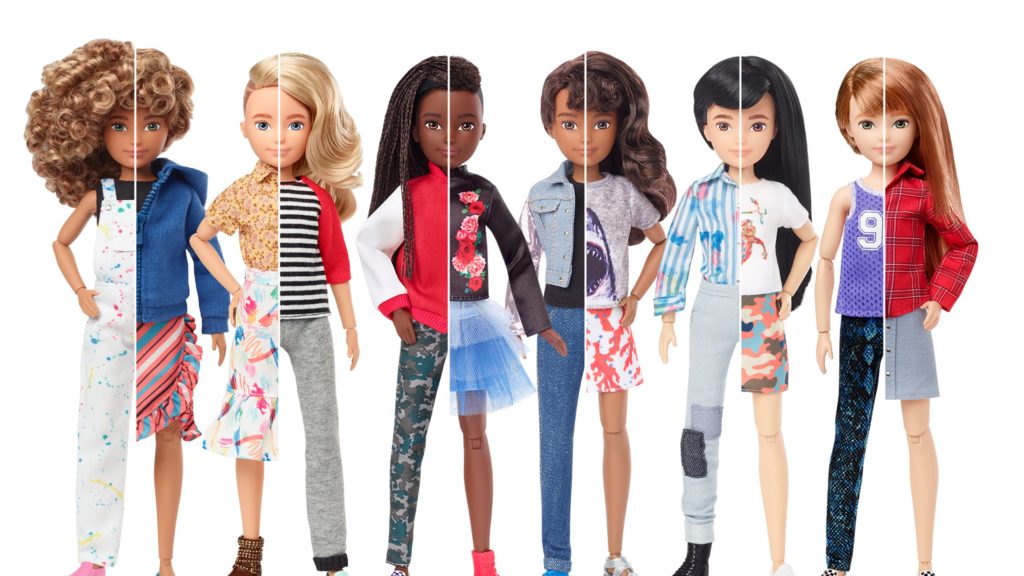
But while producing something like that means Mattel is taking a stand in one sense, it’s notably not in the main Barbie line. The Barbie line itself tends to be a bit more cautious, especially with Barbie herself.

Since the Barbie Career of the Year doll is designed to be the most discussed, and aims to make an impact in its claims about the attributes of an ideal female role-model, it is a fascinating reflection of what a group of decision-makers who are almost all women feel is the right focus for their annual feminist-yet-centrist message about what girls and women should aspire to. The bodily diversity of the Barbie line has been growing steadily, as shown in the image below of the 2019 line with its range of body types, racial characteristics, and disability representation, but the politics of careers is fascinating separately.
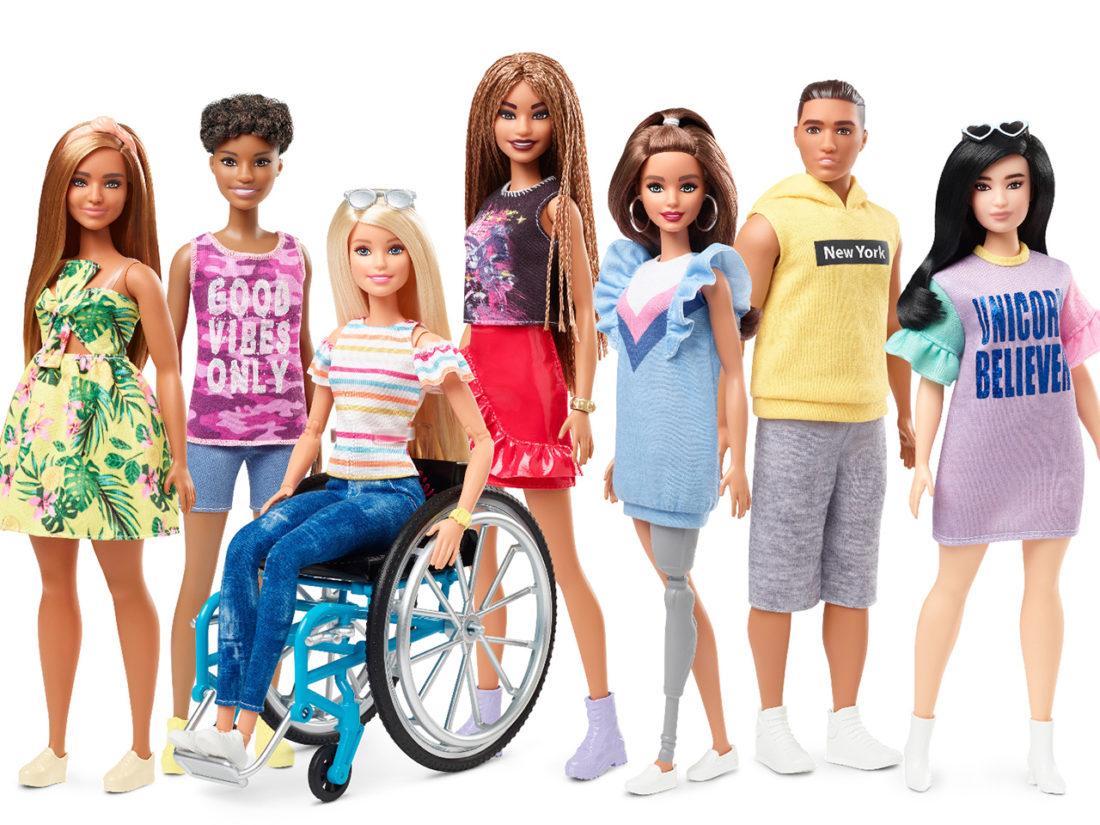
The 2020 discussion (slightly tidied w/ 2021 addition at the end):
Barbie’s 2020 Career of the Year is (for the first time) not a single Barbie but a team, a Political Campaign team featuring 4 dolls: Candidate, Campaign Manager, Fundraiser, and Voter, with diverse race and body types. Interesting to compare to past Career of the Year Barbies.
I’ll give the list of past ones first, then some analysis. Barbie had already had many earlier careers, including astronaut, president, business woman, and others, but the formal Career of the Year series launched in 2010:
- 2010 = Computer Engineer
- 2011 = Architect
- 2012 = Fashion Designer
- 2013 = Mars Explorer
- 2014 = Entrepreneur
- 2015 = Film Director
- 2016 = Game Developer
- 2017 = no Career of the Year doll for 2017 that I can find
- 2018 = Robotics Engineer
- 2019 = Judge
- 2020 = Political Campaign Team (four dolls)
- (2021 = Music Producer, not yet out when I wrote this thread)
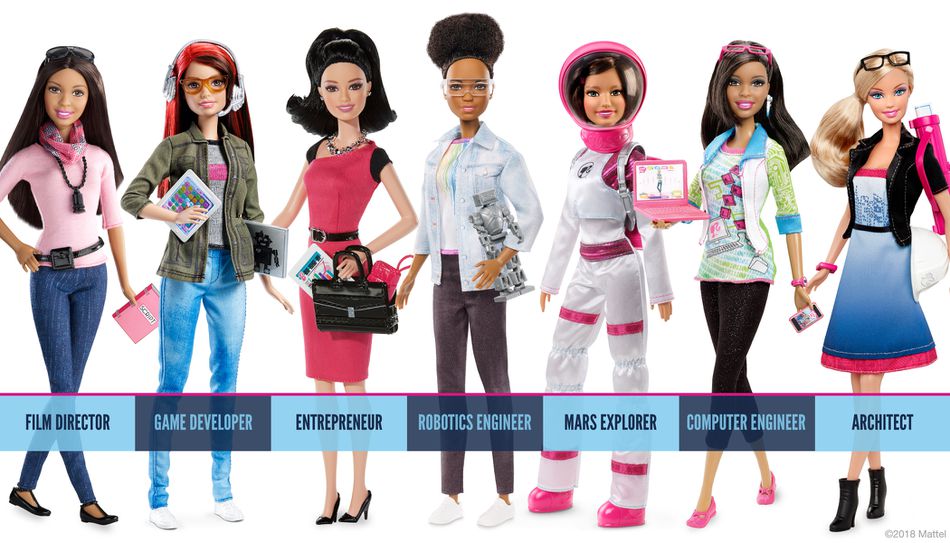
Barbie has had a lot of careers over time, including earlier iterations of astronaut and president, & her 60th Anniversary Career set has astronaut, firefighter, soccer player, airline pilot, news anchor, and “political candidate.”
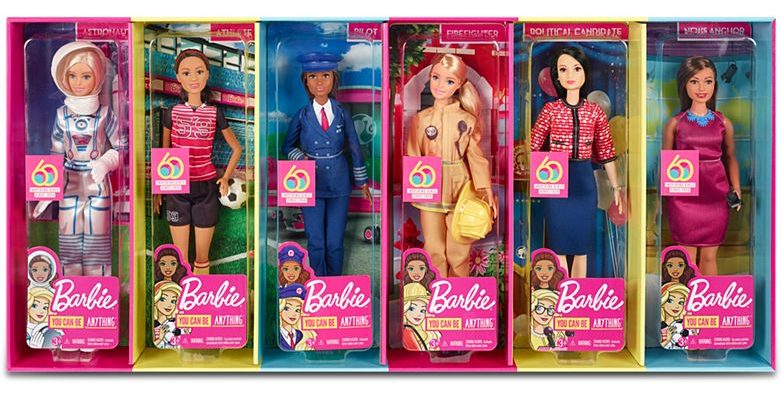
The WSJ did a great piece on Barbie’s history as a political figure back in 2016 when Barbie did a version running for president with a female running mate, clearly referencing Hillary’s campaign
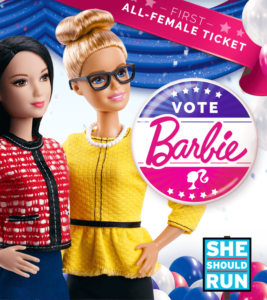 2016 was the 6th presidency-focused Barbie, making her political career thus:
2016 was the 6th presidency-focused Barbie, making her political career thus:
- 1992 = President
- 2000 = Presidential Candidate
- 2004 = Presidential Candidate
- 2008 = President
- 2012 = “Barbie for President”
- 2016 = President & Vice President candidate pair
- 2019 = Barbie 60th Anniversary Career series repackage of the 2016 presidential candidate doll in a different box w/o her VP running mate & with lighter skin & straighter hair. Fascinating.
- 2020 = Campaign TEAM and NOT SPECIFICALLY PRESIDENT
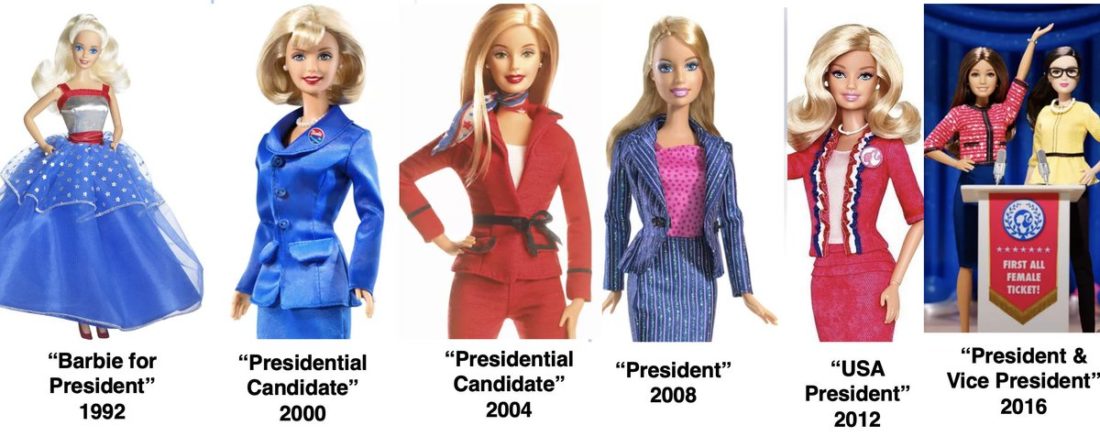
Note that 1992, 2000, 2004, 2016 & 2020 all candidates, while 2008 & 2012 are Presidents, i.e. already victorious rather than running, an interesting choice for the window right after Hillary lost to Obama in 08 primary.
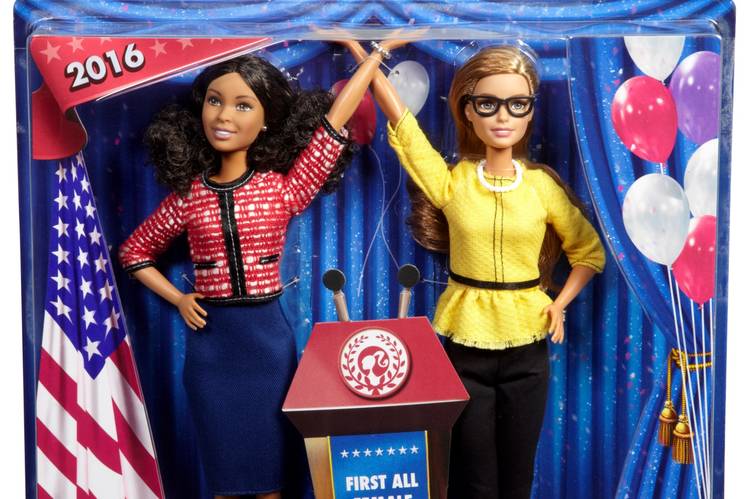
The 2016 and 2020 political Barbies have variety in skin tone and hair color, and 2020’s has variety of body type as well, in line with Mattel’s recent changes, whereas 1992-2012 are all distinctly the original blonde Barbie moving into a political career.
But no earlier president or presidential candidate Barbie was in the Career of the Year series, which is the most visibly political moment of Mattel’s year, the Barbie choice they expect to get the most discussion and spark the most newspaper coverage etc.
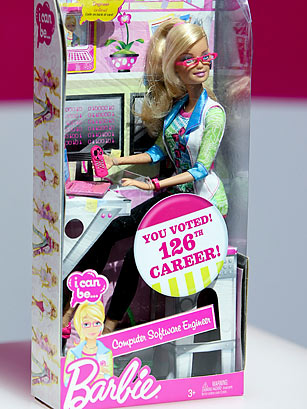 Career of the Year started as something of a disaster in 2010 when the well-meaning Computer Engineer Barbie, winner of a voting contest to pick the first Career of the Year, was launched w/ a badly-thought-through accompanying book which focused on her repeatedly messing up and needing male programmers to fix her machine (even to get rid of a simple virus!) and to turn her concept into a game.
Career of the Year started as something of a disaster in 2010 when the well-meaning Computer Engineer Barbie, winner of a voting contest to pick the first Career of the Year, was launched w/ a badly-thought-through accompanying book which focused on her repeatedly messing up and needing male programmers to fix her machine (even to get rid of a simple virus!) and to turn her concept into a game.
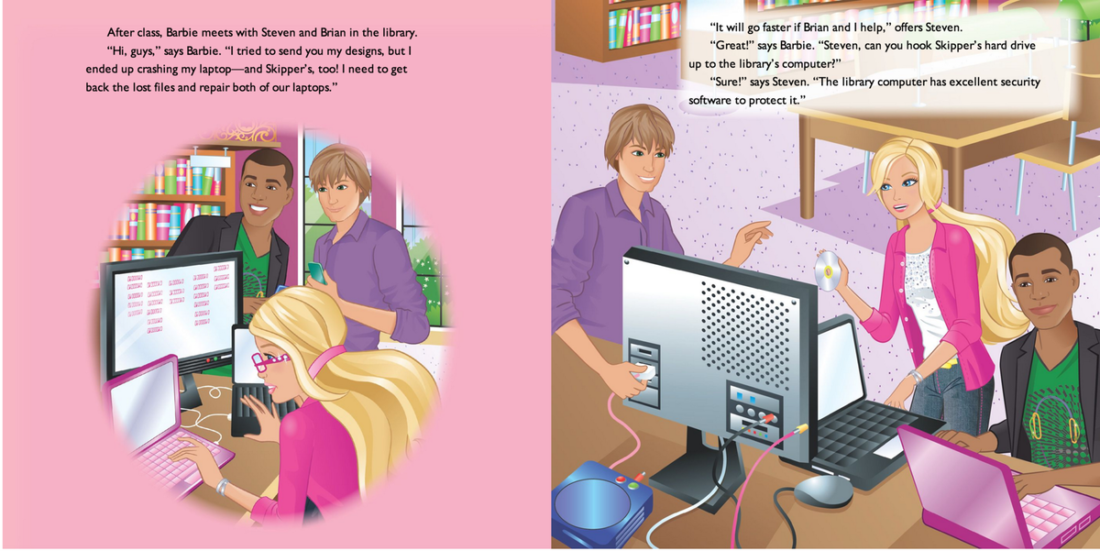
When Architect was next (2011) I remember thinking about the fact that (at the time) when you looked at lists of college majors by expected salary, architect was usually listed as the highest-paid major for women.
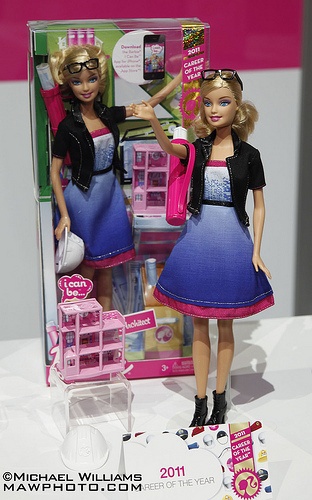
In fact the story is really cool, this great article discusses the campaign for architect Barbie, effort to convey power via her glasses & hardhat (which she never wears in the photos), & the experiments presenting her to girls to make sure the doll’s professional skill went unquestioned, unlike her computer engineer predecessor.
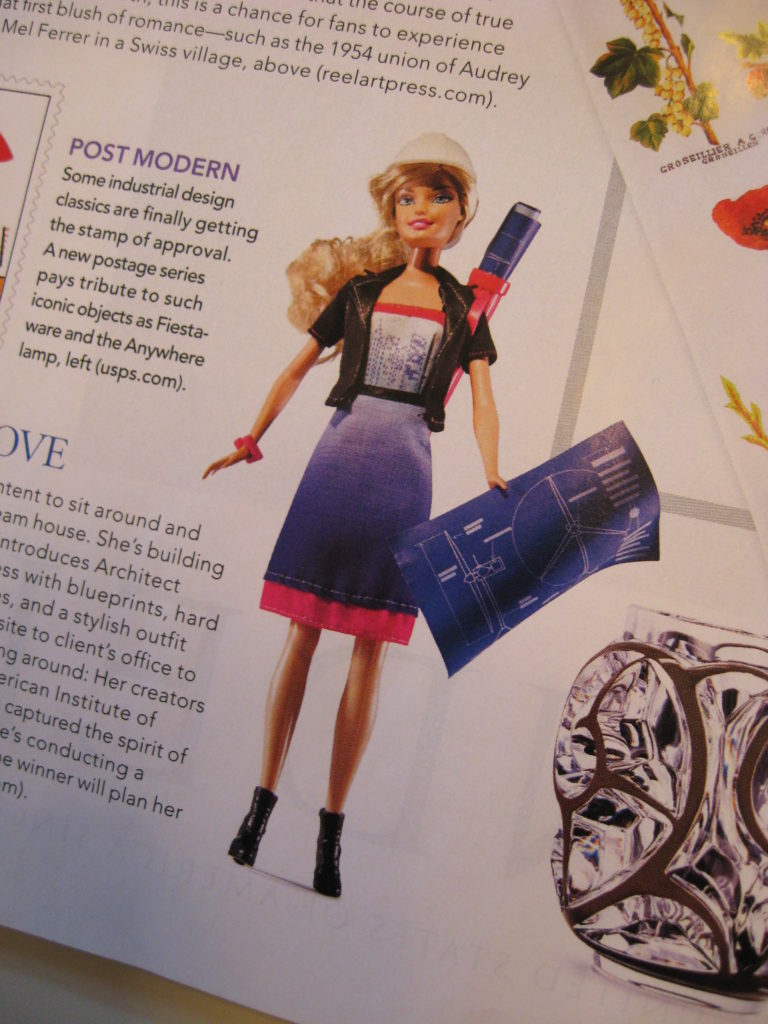
2013 Mars Explorer was the 1st mission-specific space Barbie though there had been several astronauts.
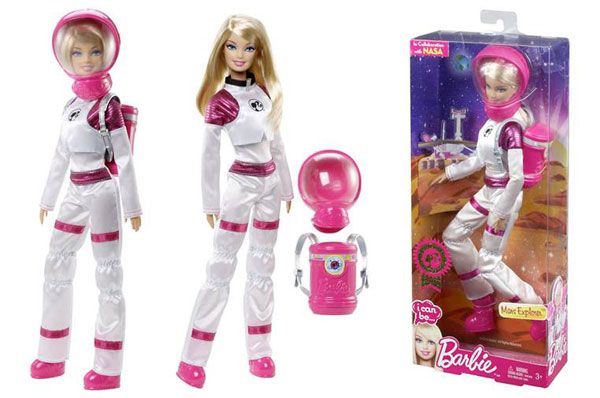
She was pinker than average though less sparkly than average, and accompanied by many science facts. Below are three earlier astronaut Barbies, for contrast:
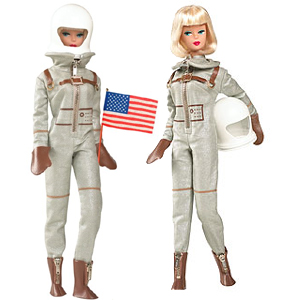
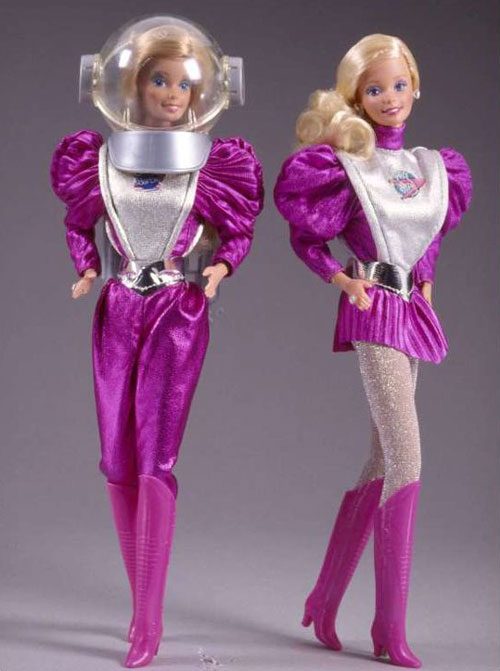
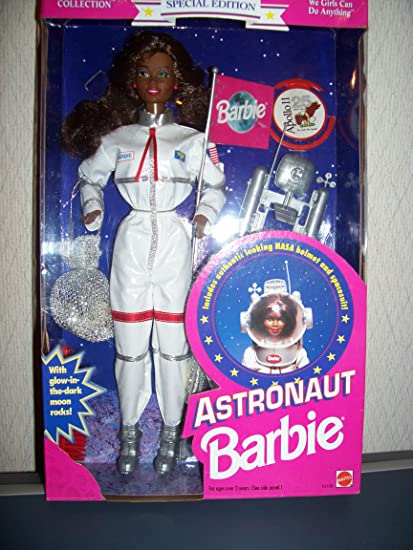
2014’s “Entrepeneur” is strangely vague, forgettable, and was much mocked at its release with headlines like “Entrepreneur Barbie will Inspire Girls to Be Vaguely Ambitious.” It was very well researched underneath, made in consultation with some major global feminist leaders like Reshma Saujani, the founder of Girls Who Code, but it struggled to get a clear concept across.
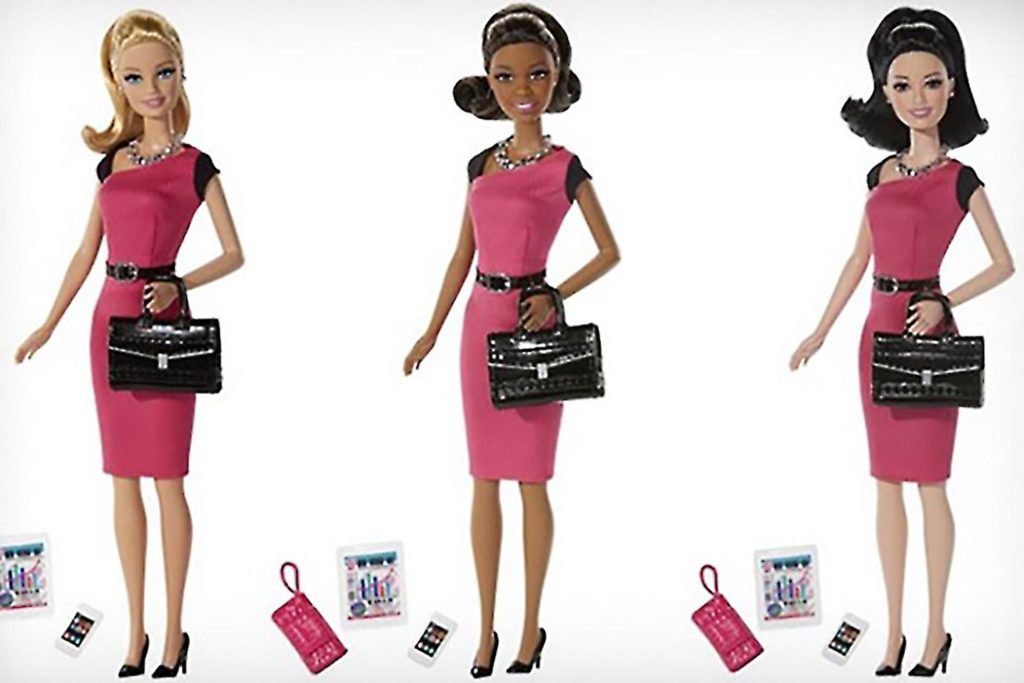
The vagueness of Entrepeneur Barbie for me is an exposure of the strained path-to-wealth archetype in our society, since it’s so much about networking, pitching, acquiring companies, buying out rivals, moving money around rather than making things; hard to describe on a box. The fact that there’s no comprehensible clear thing an entrepreneur Barbie would do or make, other than have money and move money around to make more money, is an example of how hard it is to communicate to kids how power and money really work (and how nonsensical it often is).
2015 Film Director was a clear response to discussion happening at the time about how few female film directors there were in Hollywood. She did come with several types of hair and skin tones (version options on some of these are hard to trace).
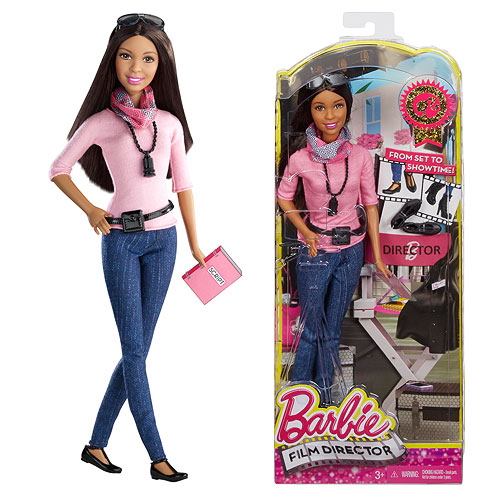
2016 Game Developer was a direct effort to redo and recover from the mistakes of the 2010 computer engineer. She (left) has one of the least pink least feminine outfits ever on a barbie, a silver (not pink) laptop and much more technical info on the box. 2010s on the right.
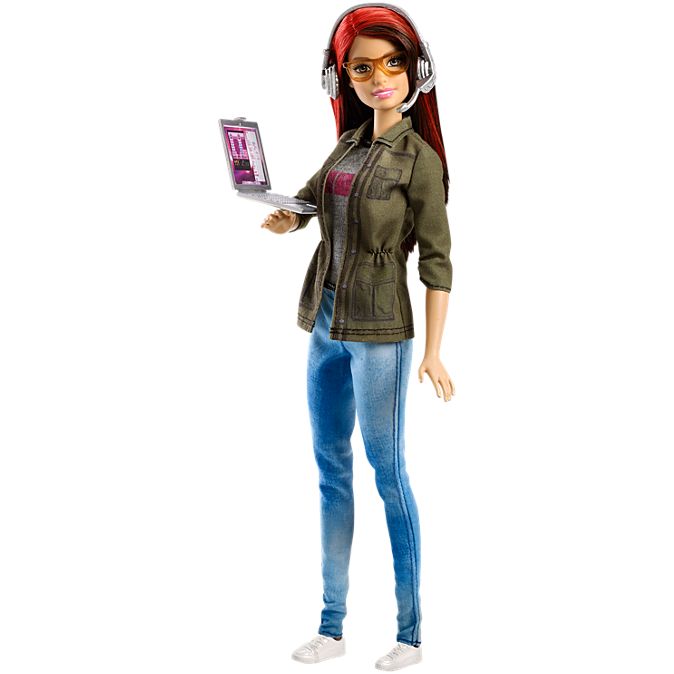
Here you see game developer Barbie next to her unsuccessful software predecessor:

One Casey Feisler on Flickr did this great compilation comparing the packaging for both plus for the 2018 Robotics Engineer career of the year Barbie. Note the new focus on precisely what she does herself not leaving it to colleagues.
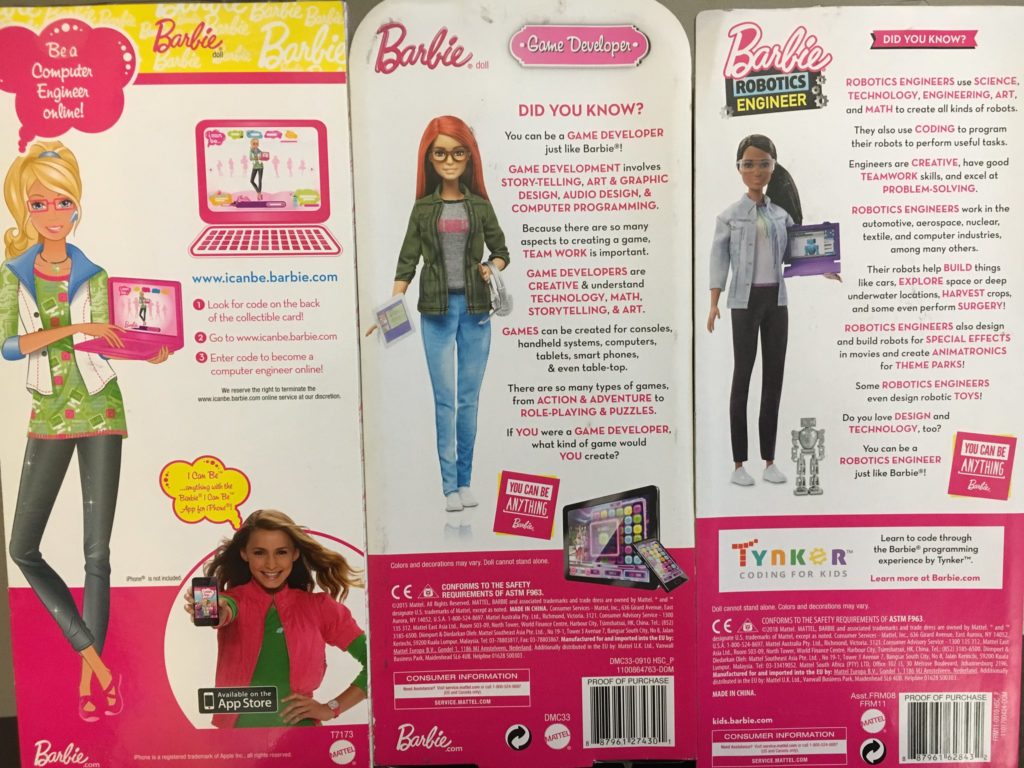
The robotics engineer doll was very similar, still glasses and a laptop, but notable for the black variant being used in publicity images a lot more, almost 50/50 with the white version.
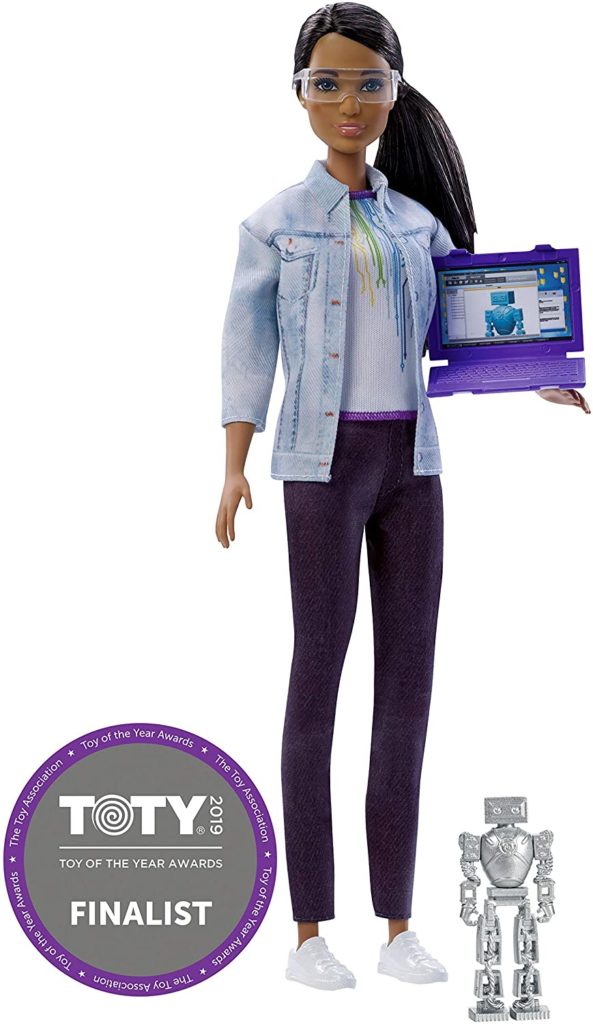
I’m still trying to figure out why there appears to have been no Career of the Year Barbie for 2017. I’ve looked and looked at this strange gap between the two very similar engineering dolls of 2016 and 2018. I’d love for someone to solve the mystery. It’s worth remembering that Mattel had very excitedly made their all-female presidential ticket President & Vice President pair in 2016 and seemed really invested in Hilary’s campaign to be the first female president – was it a morale thing that slowed them down for 2017?
Regardless, after 2018’s robotics engineer, Mattel exploded into the super political with 2019’s Judge Barbie, a clear and extremely not-neutral reference to the activities of RBG on the Supreme Court, and Republican-led stuffing of the courts. And as you can see in the image below, the 2019 judge Barbie, like the presidential set from 2016 and the two engineering Barbies, actively spotlighted its increased diversity in hair color and skin tone in its media:
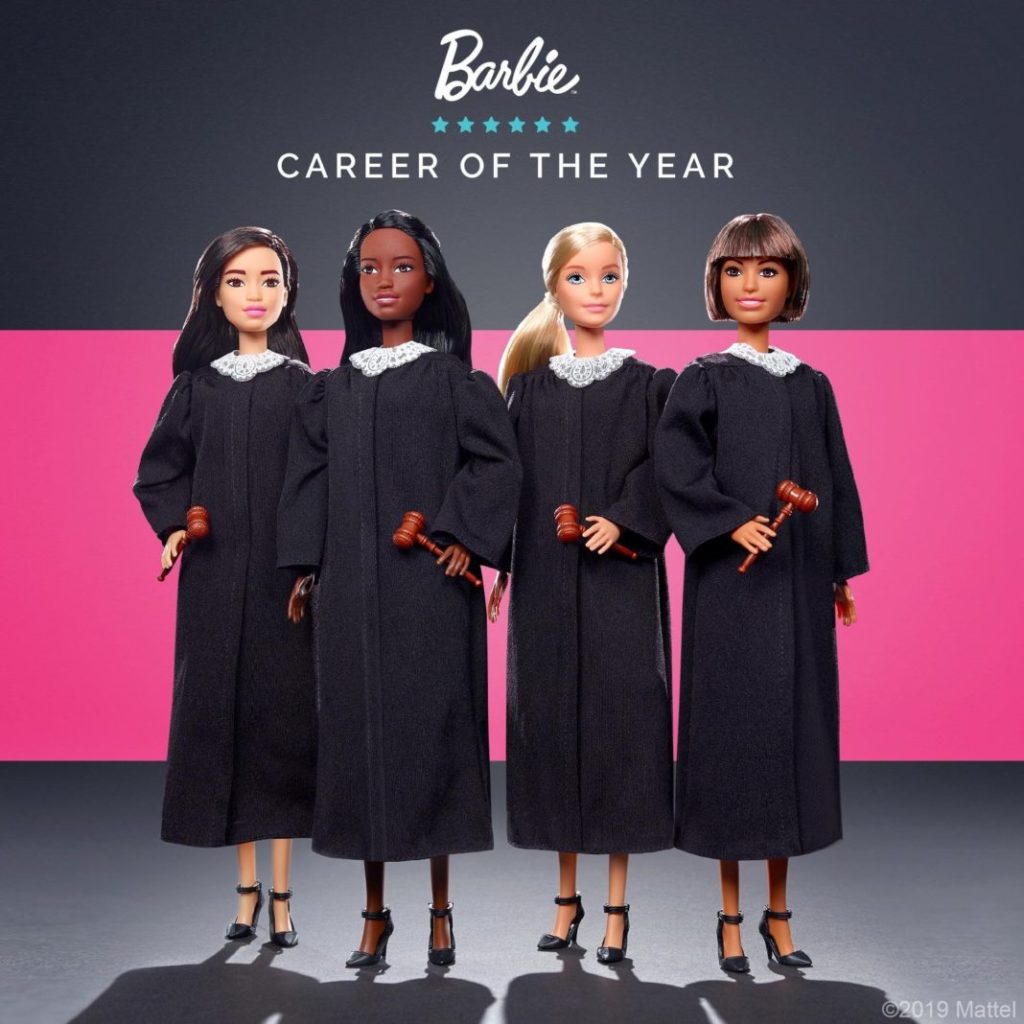
Which gets us to 2020’s Career of the Year team, the first team and, so far as I can tell, the first politically active Barbie that isn’t focused on the presidency specifically, but could be running for congress, senate, local office, anything.
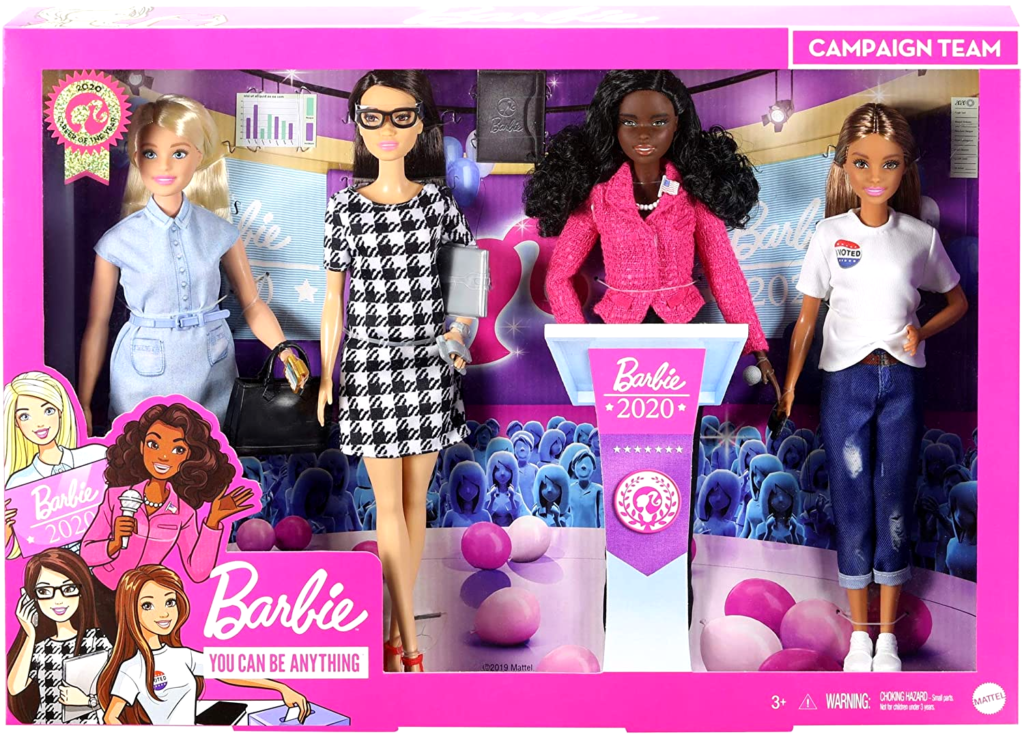
The distribution of race and body type was clearly carefully calculated, with an African American candidate, a medium-skin-toned POC-looking voter (could be Latina, First Nations, many things), and Mattel’s new heavier body type for the blonde in the role of fundraiser. It’s about teamwork, both the idea that a successful campaign requires many people beyond the candidate, & about the importance of many kinds of races, continuing Judge Barbie’s turn toward branches of government beyond the Presidency.
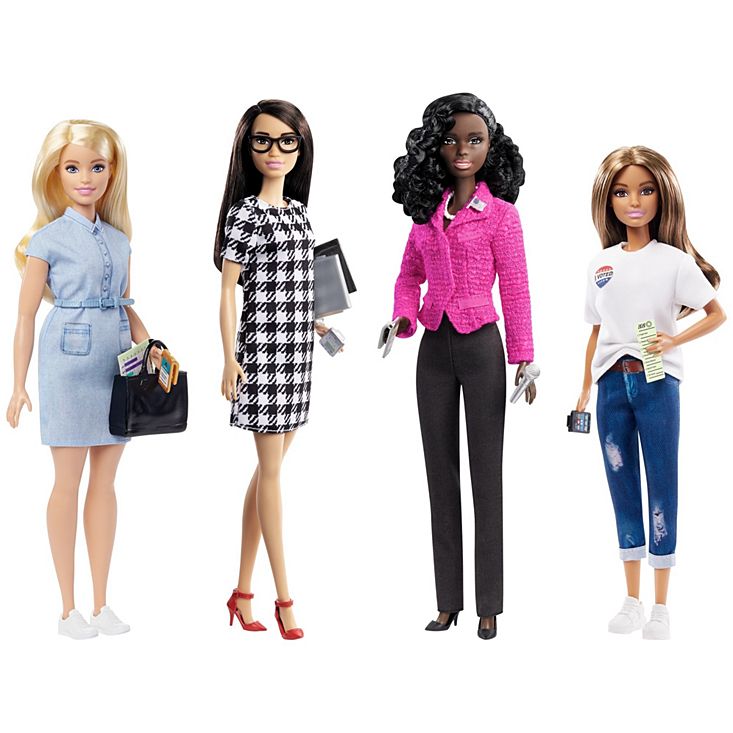
So many Barbie careers are about celebrity (actress, singer, rapper, princess) & the Presidency is a celebrity position (more so under Trump) so the break with celebrity & focus on non-famous staffers & voters & less spot-lit races is a bigger change for Barbie than it may seem. Mattel’s goal is clear, their contribution to the turn-out-the-vote movement, but I think the attention to teamwork and the importance of non-celebrity people, of the people who aren’t the center of attention, has a potential power beyond the political.
Careers of the Year have always been the one in the spotlight: the director, the architect, the designer, the one who steps on Mars, the president, with little discussion of being on the team, or the fact that movies, buildings, Mars missions are teamwork. So after six presidents or presidential candidates (and one VP) and many other Barbies-in-the-spotlight I hope this teamwork focus will help girls feel like they’re powerful even if they aren’t on the stage, in the spotlight, or in charge. A good message.
My 2020 summary thought: Keep it up, Mattel! This year’s team is great, let’s see more Career of the Year teams! Design teams, surgical teams, the Mission Control team, crisis intervention teams, pharmaceutical development teams, publishing teams (author, editor, publisher, publicist)!
My 2021 addendum: Barbie’s 2021 Career of the Year, music producer, is less remarkable than the last two in many ways, another iteration of Barbie with a pink laptop and headphones, which seems to be Mattel’s signature for Barbie-in-tech, though this one also has the music levels slider board:

Yet there are some interesting elements. Her range of unnatural hair colors is not the first in the career line, and is something Mattel appears to associate with tech as well as with music, but I find her ripped-knee jeans is notable since no earlier career Barbie wore anything quite so casual, except for the “voter” in the team set. Since this doll was certainly in development in 2020, that likely reflects the advance of casual-is-okay -for-work ideas in fashion in the age of work-from-home. That 2021’s doll is not a team does make sense in a world where work from home separated us so much, but it will be interesting to see if the solo Barbie continues to be a pattern. It is neat, though, seeing them once again showcase a job which is part of the fact that media is teamwork, i.e. the producer not the rockstar, similar to when Barbie the Film Director in 2015 directed girls’ attention to a different type of power in Hollywood from the many movie star Barbies of earlier Barbie decades. In a sense it’s a job which showcases teamwork even while alone, and thus very apt for 2020/2021, and perhaps a good sign for Mattel continuing to think about teamwork and plural agency even in their solo dolls. And the fact that it got much less media attention than judge or political team may mean that the forces of capitalism step in to encourage Mattel to try something bolder next year–we must never forget the $$ side of commercial political messaging.
So, what does the Career of the Year sequence show us about Barbie as a mark of centrist feminism? A few things. One is that women-in-tech is definitely a thing, far more in the minds of the organizers than women-in-STEM, since we haven’t seen biologist Barbie or epidemiologist Barbie showcased, only several iterations of tech Barbies, including software and hardware. It also shows through things like entrepreneur Barbie and architect Barbie that sometimes they look a lot at research, especially about income and what are high-paying careers, and think it’s important that Barbie encourage girls to go into high-paid professions not just exciting ones (beloved-yet-underpaid careers like teacher and nurse have been frequent Barbie careers but not showcase ones). They also sometimes run into challenges in communication, i.e. ‘entrepeneur’ is a very important concept but very difficult to communicate in a doll via clothing and accessories, as is true of many careers.
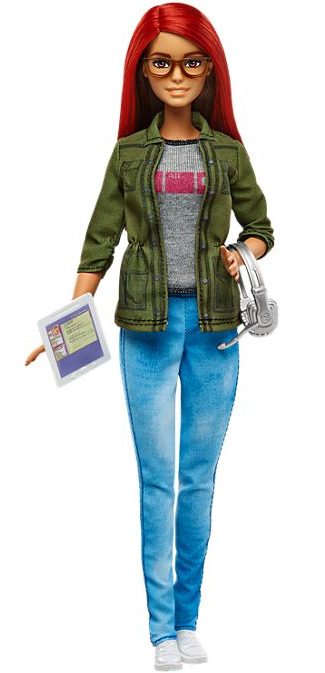 Several of the career Barbies–notably game designer and music producer–have been major steps in more casual clothing, which is a not insignificant message when we think of the target market largely including middle-class suburban mothers (parents buy the toys more often than kids, after all) who are thus expected to consider ripped knees and wild hair a respectable image for girls to aspire to. The increase in tightly-fitted-yet-somewhat-ungendered clothing, which reached its peak with the carefully-planned game designer doll, is also notable. Recalling how much fashion pressures linger in business, how many employers still expect makeup and highly feminine dress for all women, the dolls’ statement that sneakers, jeans, and a shirt and jacket whose only feminine coding lies in the tightness of their fitting and the small amount of pink on the shirt is a genuinely significant change. That 2021’s is a step more feminine in coding even as it is a step more casual is interesting when put in dialog with gender and transgender issues becoming such a hot topic in the past few years.
Several of the career Barbies–notably game designer and music producer–have been major steps in more casual clothing, which is a not insignificant message when we think of the target market largely including middle-class suburban mothers (parents buy the toys more often than kids, after all) who are thus expected to consider ripped knees and wild hair a respectable image for girls to aspire to. The increase in tightly-fitted-yet-somewhat-ungendered clothing, which reached its peak with the carefully-planned game designer doll, is also notable. Recalling how much fashion pressures linger in business, how many employers still expect makeup and highly feminine dress for all women, the dolls’ statement that sneakers, jeans, and a shirt and jacket whose only feminine coding lies in the tightness of their fitting and the small amount of pink on the shirt is a genuinely significant change. That 2021’s is a step more feminine in coding even as it is a step more casual is interesting when put in dialog with gender and transgender issues becoming such a hot topic in the past few years.
And, of course, we saw with judge Barbie and the political candidate team Barbie that a lot of people who consider themselves politically fairly neutral/centrist, including Mattel, felt that the wake of Trump’s election and the midst of the authoritarian surge of 2016-2020 was an important moment to step forward, become more active, and, for the first time in Barbie’s history, to take a semi-overt political stance, since celebrating judge Barbie in the midst of so much focus on Ruth Bader Ginsburg, is not explicitly pro-Democratic-party but it’s extremely clear the way it leaned. Many organizations that strive for party neutrality, from Mattel to the ACLU to the science journal Nature, felt that Trump’s second run was the moment to use that history of neutrality for an important end, since breaking a multi-decade string of never endorsing one party over the other makes the moment when one does speak out that much more powerful. That 2021’s doll is far less political, except for being pro women-in-tech, raises the question whether we should view the renewed projection of party neutrality as a happy return to normal, or as a scary sign that the wave of sudden political engagement sparked in 2016-20 is fading again, and that voter turnout may wane with it.
In sum, since news and social media both tend to magnify radical voices on both sides, things like Mattel’s carefully-calculated political stances can be a valuable window on the often-quieter middle, though whether it really is the middle or just attempting to claim “this should be the middle!” as the real middle moves left and right is another question. And the fact that the fashion-focused “Fashionistas” line and new sets like the glamorous bond-movie style “Spy Squad” Barbie set persist alongside our career Barbies also shows that the extremely gendered Hollywood femme fantasy side of Barbie is still just as strong in the moderate center of this particular feminine ideal as all the politically-progressive versions are (if not stronger since the fashion focused Barbie lines are usually much larger than the career sets). Of the nine dolls in the 2016 splash add below, one-third are narrative-free fashion-consumers, one-third Hollywood fanatsy babes, and one-third career role models, a telling microcosm of the imagery proportions kids are pelted with. Ongoing food for thought.
